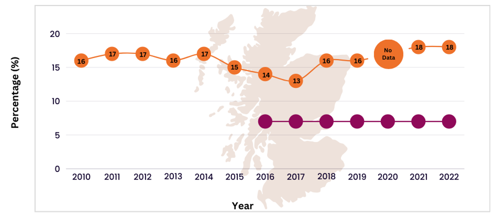Scottish Health Survey 2022 - Summary & Response
05 December 2023
Headline findings from the data for 2022 show that 67% - more than two-thirds – of adults are living with overweight and obesity in Scotland, which is the same level as in 2021. Men remain more likely than women to have overweight and obesity (70% vs 63%). For obesity specifically, 29% of the population now lives with obesity, which represents a slight decrease from the 2021 figure of 30%, and 4% of adults live with severe obesity, which has remained fairly static in recent years.
The data for children paints a worrying picture. The 2022* data highlights that a third of children (33%) aged 2-15 are at risk of overweight and obesity. This is the highest figure recorded by the survey since 2011** and represents a stark increase from the immediate pre-pandemic years. Just under a fifth (18%) of children are at risk of obesity, which is the same as in 2021. This means there continues to be a lack of progress towards achieving the Scottish Government’s ambition to halve childhood obesity by 2030, as outlined in the graph below.

Lorraine Tulloch, OAS Programme Lead said:
“No progress has been made towards the ambition of halving childhood obesity by 2030. There is now a higher proportion of children living with obesity than when Scottish Government made that commitment. We have had no progress since 2018. That is not good enough. We believe that healthy weight matters and every child deserves the opportunity of a healthy childhood and adulthood. If politicians are committed to improvement then they need to take bold action to remove unhealthy foods from the spotlight.
We need to see the legislation to restrict the promotion of foods high in fat, sugar and salt progressed without any further delay. Children report seeing adverts everywhere, every day. We need to change that environment to support them to make the healthy choice.”
Maternal obesity data – Headline results
Last week, the latest statistics for maternal BMI in Scotland were published in the 2022/2023 Births in Scotland report. This reports data on the weight status of expectant mothers at their first ante-natal appointment.
The report shows maternal obesity is continuing to rise, reaching a record prevalence of 27.9% over the past year. When combined with overweight, more than half (56.5%) of expectant mothers had overweight or obesity. The data also shows inequalities remain between minority ethnic groups and across deprivation groups. Over 60% (60.9%) of expectant mothers in the most deprived quintile had overweight and obesity, compared to only 49.3% in the least deprived quintile.
The weight status of expectant mothers matters for both the health of the mothers and their children. Babies born from mothers with overweight and obesity are 2-3 times more likely to be of a high birth weight (categorised as being 9lb or over) and maternal obesity is also associated with a greater risk of miscarriage, death during labour, and stillbirth.
*Over recent years of the survey, there have been several changes to the reporting methodology for population weight and diet statistics, in response to the Covid-19 pandemic. Limited data was collected in 2020, and data on weight was gathered via a telephone survey in both 2020 and 2021. There was also a significantly reduced sample size in the 2020 survey. Self-reported data is known to be less accurate than measured data, with individuals more likely to overestimate height and underestimate weight. The 2022 survey has returned to the previous pre-pandemic methodology with the data gathered in person by a researcher. The BMI data included in the survey for children is measured data, with some self-reported data for adults. We welcome the inclusion of measured data within the survey.
**The figure was also 33% in 2011 and 2008. 33% is the highest figure ever recorded by the survey
 Healthy Weight Data & Info
Healthy Weight Data & Info
 *THE PLEDGE CAMPAIGN* Child healthy weight matters to me!
*THE PLEDGE CAMPAIGN* Child healthy weight matters to me!